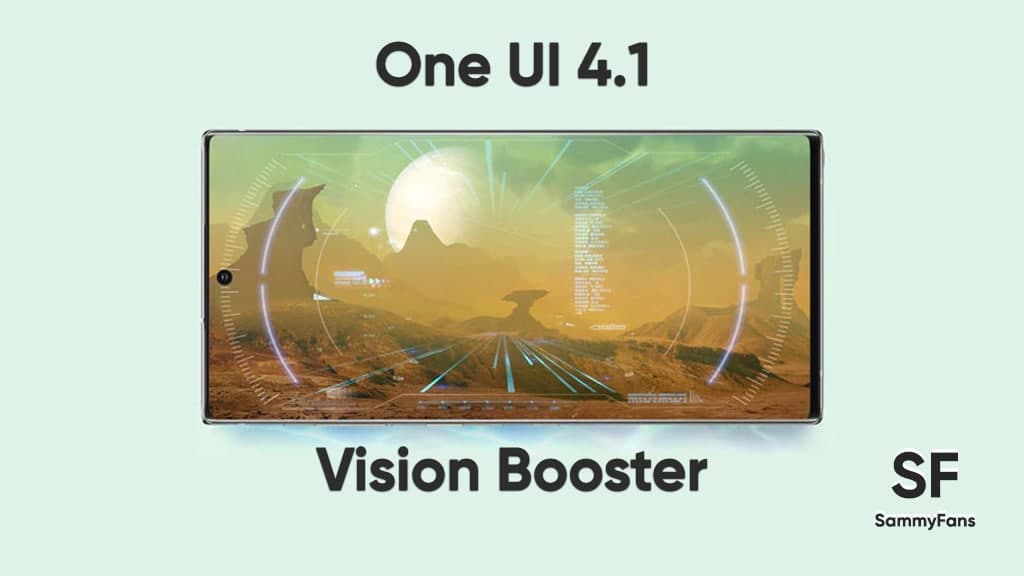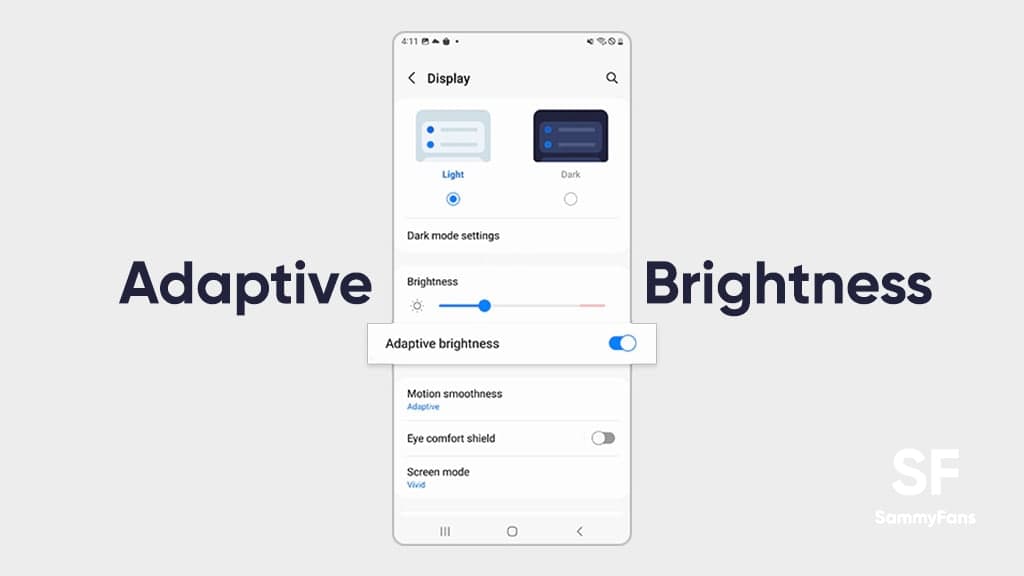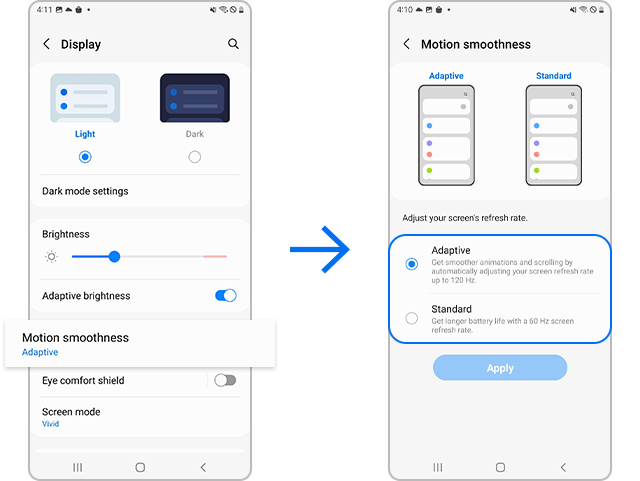News
Samsung One UI 4.1 has new ‘Vision Booster’ features

Samsung Galaxy S22 series offers the ultimate exterior visibility with Vision Booster’s improved display brightness and intelligent algorithms. Advanced AI camera features make every experience epic and provide amazing shots from different angles and in different lighting conditions. Furthermore, it is the first model in the Galaxy S series with a built-in S pen.
With the advanced display features of the Galaxy S22 series, you will experience a visual improvement in any lighting conditions you encounter. Thanks to Vision Booster and Intelligent Adaptive Refresh Rate, you can enjoy bright videos and other media with better color contrast.
One UI 4.1 Vision Booster
One UI 4.1-based Vision Booster is a technology that provides tone mapping for better visibility against strong light in outdoor conditions. Vision Booster’s algorithm analyzes the histogram data of the entire content displayed on the display, observing the value of each pixel.

After that, it does tone mapping to adjust the display, making dark areas brighter and colors richer, increasing color contrast to sharp images even in direct sunlight.
Use a high refresh rate to prevent the screen from blinking when switching between screens. The screen scrolls more smoothly. When you select the standard refresh rate, you can use the battery longer.
How to set Motion Smoothness on your Galaxy S22?
Use a high refresh rate to prevent the screen from blinking when switching between screens. The screen scrolls more smoothly. When you select the standard refresh rate, you can use the battery longer.
- Go to the Settings screen and tap on Display> Motion Smoothness.
- Select the Refresh rate.

Adaptiv: Achieve smooth animations and scrolling by automatically adjusting your screen refresh rate to 120Hz.
Standard: Use the standard refresh rate under normal conditions to save battery power.
Adaptive brightness
You can set the device to track your brightness adjustments and apply them automatically in similar lighting conditions.
- Go to Settings> Display> Adaptive Brightness.

Extra Brightness
Extra Brightness mode provides greater brightness in indoor conditions. This feature is available when you deactivate the Adaptive Brightness feature.
Go to Settings> Display> Adaptive Brightness Off> Extra Brightness On.


Get notified –
Aside from SammyFans’ official Twitter and Facebook page, you can also join our Telegram channel, follow us on Instagram and subscribe to our YouTube channel to get notified of every latest development in Samsung and One UI ecosystem. Also, you can follow us on Google News for regular updates.
News
Apple’s RCS adoption unites Android, One UI and iOS users with crazy messaging features

Samsung believes wider RCS adoption unites Android (One UI) and iOS users. The company has been working with Google to evolve the next-gen messaging standard. After a long-standing moral fight, Apple adopted RCS across its products.
Apple iOS now supports RCS messaging standards, uniting iPhone users with Android and One UI users. Samsung and Google together worked hard for RCS evolution and ran a campaign #GetTheMessage to put pressure on Apple.
Text messaging has undoubtedly become a key part of how we connect. Rich Communication Services (RCS) is a modern, interoperable standard that evolved in close collaboration between Google and Samsung.
RCS is quickly becoming the universally adopted, modern messaging standard. As the world becomes more interconnected, this open, collaborative approach across the industry will be a key factor in enabling better experiences for all.
RCS unlocks a world of rich, seamless messaging on Android and iOS devices. As it’s now also available on Apple iOS devices, the key advantages of RCS when messaging between Android and iOS devices include:
- High-quality media sharing: Users can send high-resolution images and videos across Android and iOS devices, making sharing special moments in greater detail and clarity easier.
- Text Reactions: Users can react to messages with emoji or other expressions, similar to social media, making conversations more interactive and personal.
- Enhanced group chats: In group chats, users can add or remove other users whether they use Android or iOS.
RCS unites Android, One UI and iOS
RCS expansion to iOS takes the industry one step closer to a universal seamless messaging experience. Samsung has worked closely with Google for years to establish RCS as a universal standard that improves the messaging experience.
“We’ve been working with Google on RCS for years to provide users with a seamless, connected messaging experience,” said Patrick Chomet, EVP and Head of Customer Experience, Mobile eXperience Business at Samsung Electronics.
Android and One UI have united for years and the partnership is reaching new milestones. As Apple iOS 18 supports RCS, rich messaging features are now available beyond the Android and One UI ecosystem when messaging across platforms.
“We have worked hard for years to make RCS the standard for improved cross-platform messaging, and Samsung has been instrumental in the growing adoption of RCS,” said Sameer Samat, President of Android Ecosystem at Google.
News
Samsung boosts HBM capabilities with new investments

Samsung has reportedly signed a contract valued at around $15 million to sell and purchase semiconductor equipment to expand HBM chip production facilities at its Suzhou plant in China.
BusinessKorea reports that Samsung is expanding its investments across HBM facilities. The company aims to strengthen its advanced semiconductor packaging to lead the supply chain.
Eying the HBM4 chip boom, the Korean tech giant is focusing on enhancing its packaging capabilities to secure future technological competitiveness and narrow the gap with SK Hynix.
KEDGlobal revealed that Tesla asked Samsung and SK Hynix to supply HBM4 samples. The US EV maker could choose either Samsung or SK Hynix as its HBM4 supplier after testing samples.
Pay attention, packaging includes the tech and processes for shaping semiconductor chips to fit the devices they will be mounted on – making it an important aspect of development and production.
Notably, the Suzhou China facility is currently Samsung’s test and packaging production base outside Korea. Increased investment is seen as a choice for innovation in packaging processes and production efficiency.
Apart from this, the company is also ramping up its packaging production bases in Korea. Samsung has recently signed an investment agreement with South Chungcheong Province and Cheonan City.
News
Samsung could get a major role in Tesla’s AI revolution

Tesla reportedly asked Samsung and SK Hynix to supply HBM4 chip samples. Both semiconductor firms are developing sixth-generation high-bandwidth memory chip prototypes for Tesla.
KEDGlobal reports that Tesla asked Samsung and SK Hynix to supply HBM4 chips for general use. It is expected to choose one of the two companies as its HBM4 supplier after testing their samples.
Using custom HBM4 chips made by Samsung and SK Hynix, Tesla seeks to enhance its artificial intelligence (AI) capabilities apart from reducing AI chip reliance on Nvidia.
Samsung is working hard to win Tesla orders for HMB4 chips. The company even working with Taiwan’s TSMC to foster its HBM chip’s development and maintain an edge over SK Hynix.
SK Hynix is also accelerating its development to maintain its leadership in the HBM space. The firm winning Tesla’s HMB orders would see a sharp push in the global memory supply chain.
Notably, the 6th-gen HBM4 chips are crucial for Tesla’s Dojo supercomputer, which is designed for training AI models and will also support its AI data centers and autonomous cars.
The HBM4 semiconductor offers notable enhancements over the previous generations, delivering up to 1.65 Tbps of bandwidth, 1.4 times faster than the HBM3E while consuming 30% less power.












